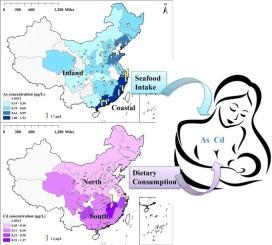中国母乳中重金属含量:第三次全国母乳调查结果
IF 11.3
1区 环境科学与生态学
Q1 ENGINEERING, ENVIRONMENTAL
引用次数: 0
摘要
为了调查婴儿在哺乳期间重金属的暴露情况,对中国24个省份的母乳进行了检测。在As、Cd、Cr、Hg、Pb中,母乳中As (85%, 0.50 μg/L)和Cd (91%, 0.15 μg/L)的检出率较高。沿海省份母乳中砷的浓度明显高于内陆省份,这种差异与海鲜的摄入密切相关。南方省份母乳中镉含量明显高于北方省份,这一差异与饮食中镉的摄入有显著关系。与第二次全国母乳调查结果相比,第三次全国母乳调查中砷、镉、铅含量明显下降。此外,与全球母乳中重金属含量相比,中国母乳中的重金属含量相对较低。对婴儿的风险评估表明,中国大部分地区母乳中的重金属不会对健康造成危害。持续监测母乳中的重金属水平对母乳喂养婴儿的健康至关重要。本文章由计算机程序翻译,如有差异,请以英文原文为准。

Occurrences of heavy metal in breast milk in China: Results of the third National Breast Milk Survey
To investigate the exposure of infants to heavy metal during lactation, breast milk from 24 provinces in China were detected. Among As, Cd, Cr, Hg, and Pb, the detection frequencies of As (85%, 0.50 μg/L) and Cd (91%, 0.15 μg/L) in breast milk were notably high. The concentrations of As in breast milk from coastal provinces were significantly higher than those in inland provinces, the discrepancy that was strongly associated with the intake of seafood. The levels of Cd in breast milk were markedly higher in southern provinces than those in northern provinces, the distinction that was significantly linked to the dietary consumption of Cd. Contrasting with the findings of the second national breast milk survey in China, the levels of As, Cd and Pb in the third one decreased evidently. Moreover, comparing to the global levels of heavy metals in breast milk, their levels in Chinese breast milk were comparatively low. Risk assessment for infants showed that heavy metals in breast milk from most regions of China did pose no health hazard. Continuous monitoring of heavy metal levels in breast milk is crucial for the health of breastfed infant.
求助全文
通过发布文献求助,成功后即可免费获取论文全文。
去求助
来源期刊

Journal of Hazardous Materials
工程技术-工程:环境
CiteScore
25.40
自引率
5.90%
发文量
3059
审稿时长
58 days
期刊介绍:
The Journal of Hazardous Materials serves as a global platform for promoting cutting-edge research in the field of Environmental Science and Engineering. Our publication features a wide range of articles, including full-length research papers, review articles, and perspectives, with the aim of enhancing our understanding of the dangers and risks associated with various materials concerning public health and the environment. It is important to note that the term "environmental contaminants" refers specifically to substances that pose hazardous effects through contamination, while excluding those that do not have such impacts on the environment or human health. Moreover, we emphasize the distinction between wastes and hazardous materials in order to provide further clarity on the scope of the journal. We have a keen interest in exploring specific compounds and microbial agents that have adverse effects on the environment.
 求助内容:
求助内容: 应助结果提醒方式:
应助结果提醒方式:


